Before :
After :
How to do ?
This victim is a 40 years old Bina Musicals sitar from Delhi.
What you need is a small bottle with popote and 2 pieces of clean cotton cloth.
Popote is an amazing strong natural cleaning product, especially made for shellac finish polished bodies.
It removes all dirt and grease, and restores the finish to its original state and makes it shining as new again.
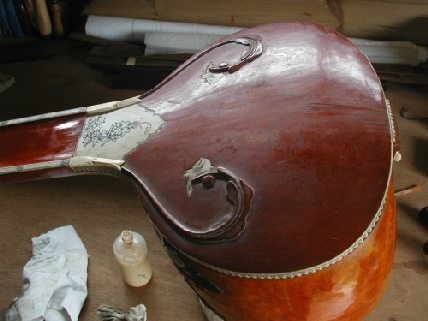
Shake the popote very well !!! and apply 2-3 drops on a small piece of cotton cloth.

Rub it firmly on the dirty surface. Work in a small zone (approx. 10cms x 10cms) at the time.
As the dirt comes off, the cloth becomes black and the surface looks mat.

Before the popote dries completely up, rub the cleaned zone with another clean cotton cloth. Then the surface becomes shiny.
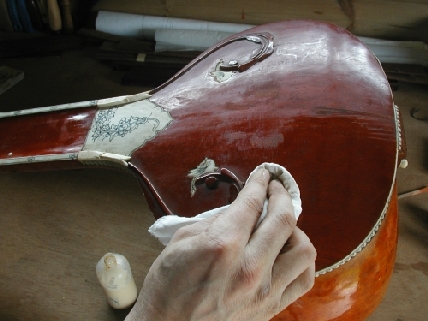
If the surface was very dirty, repeat the process untill no more dirt is to be removed – the cotton cloth remains clean too.
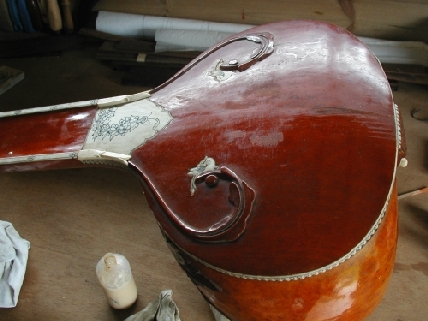
Complete the whole instrument, working on zone after zone.
Finally rub the whole surface with the clean cotton cloth.
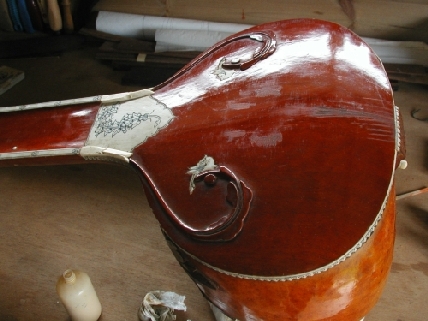
The instruments’ shellac finish looks like new.
VERY IMPORTANT is that you shake the popote very well and surely almost constantly during use (firmly just before applying some drops on the cotton).
Also work on small zones one by one covering the whole surface at the end.
Try to avoid to touch metal parts since popote possibly can cause oxidation on the metal surface.

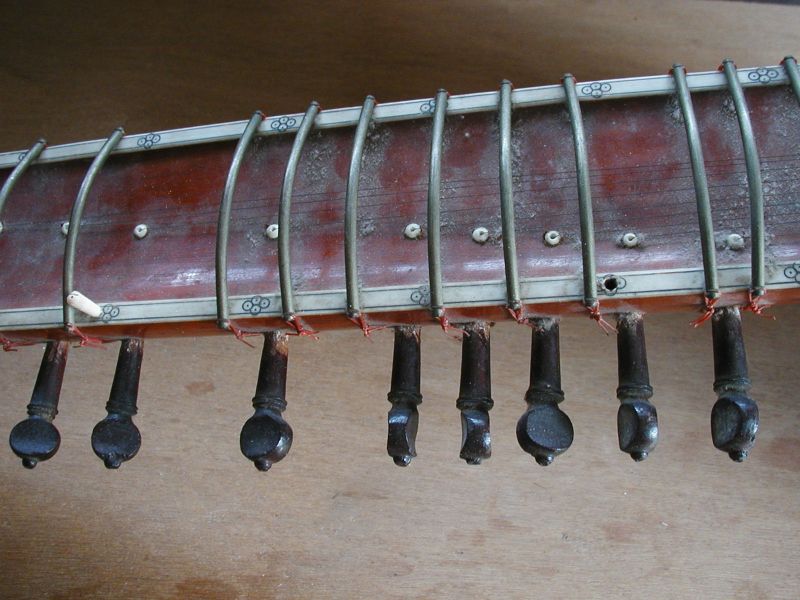

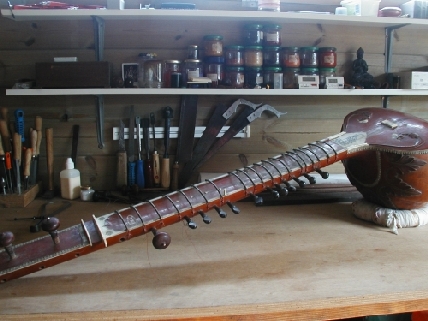

Do you use the same stuff to polish the actual gourd too?
What’s a good way to clean out the dust and debris between the decorating wooden leaves and the gourd too please?
This popote is only for cleaning purpose (also on the gourd). The polish is a shellac solution with alcohol. It is used on the gourd too. The technique is called “french polishing”…
The dust and debris in the decoration can be removed with a small and rather stiff brush or with compressed air. It is very difficult to remove it all, so better is to prevent too much dust coming close to your instrument. Cover it with a simple light cotton cloth.
I cleaned my celluloids with a rubber eraser this works fine and is not a to rigid procedure.
I love your site, very good!!
Sitar and Surbaharplayer since 30 years and always on the job of doing all kind of maintanance as usual.
Hello Raj,
Cleaning the celluloid inlays (removing the left-over varnish) can be done by scraping it off with a scraper.
A scraper can easily be made from an old piece of iron saw.
Click here for some samples of a scraper…
Make it nicely straight and sharp, and scrape the varnish gently but fluently off the inlays. But watch out for sliding out. Keep your scraper almost perpendicular to the surface, and “feel” the edge of the scraper crush and scrape. Move steady. You can always have some practise first on a piece of cheap plastic or wood.
Hi,
How can I clean the celluloid inlays used on old sitar which has tarnished?
Your site is very informative and useful. Keep up the good work!
Thanks.
It is a good cleaner for french polish treated finish. I buy mine at http://www.cmbpuurs.be/. It is labelled : SUPER NIKCO popotte and is made by Hedin Marit Bourdier, Rue de Prague 8, Paris.
i cant find popote in the u.k what is this, is it french polish? your web site is the best Sitar web site there is keep it up, i love it.
Your website is great. I am based in Slough in England, I play the sitar and Surbahar. I have repaired several sitars and I do jiwaris regularly, I read your site regularly. it is one of the best, keep the good work going. Malkeet
You should be able to find this popote at stores specialised in antique and restauration or at luthier stores. It cleans the shellack finish (cfr. french polishing, which is based on alcohol) very good.
Here in Belgium, you can find a good special luthiers quality at CMB : http://www.cmbpuurs.be/
Succes
This looks like a great product that will probably fix the same condition a sitar I have is in.
Where can I get this popote?